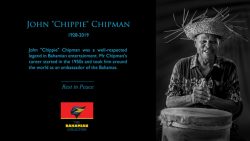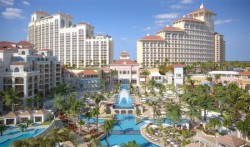Gentle, genteel, modest, humble, honest, understated, nervous when necessary, helpful, giving, encouraging, quietly forceful, open minded, a true Bahamian first and foremost, focused, professional, a passionate Artist and Visionary.
This is Brent Malone . . . . now, the late Brent Malone, one of our number.
Richard Brent Malone, born in Nassau in 1941, knew from the age of 12 years that he would be an artist. When he was only eight years, six different friends gave him painting-by-number sets, having heard some of his interest in art. The next year, he put the word out; that cash would be appreciated as he had started a savings account to pay for his eventual training. He spent two years studying with Don Russell of Don Russell’s Academy of Fine Arts, honing his skill with a paint brush and became the first Bahamian to pass “A” Level Art with distinction.
From Don Russell’s Academy, it was on to Chelsea Pottery. “If it wasn’t for Chelsea Pottery I might have been an insurance salesman,” Brent told Patrick Rahming.
Sir Harold Christie was well known in the Bahamas of the 1950s and ’60s. He had been as successful in politics as he had been in real estate sales, and was a wealthy man. But as a politician, he may have “accidentally” opened the door to one of the greatest periods of Bahamian artistic expression so far, of helping to shape the course of artistic development in the second half of the 20th century.
In an effort to gain political mileage, Mr. Christie proposed to one of London’s most prestigious potteries that they open a branch in his constituency of Cat Island. It could create employment as well as provide an outlet for the island’s creative imagination. Their response sent David Rawnsley to The Bahamas.
But Rawnsley convinced Sir Harold that the pottery should be located in Nassau, where it could offer an outlet to the whole country, and the Nassau studio of Chelsea Pottery opened its doors in 1957 on the site of the present Post Office. It was financed by Sir Harold, and never met either its financial or its political objective. It never broke even, and it never provided significant employment, so after only a few years the doors closed, the property was sold, and the staff, local and foreign, dispersed.
In fact, the Chelsea Pottery was one of the most spectacular successes in artistic history. It brought together a group of young Bahamian artists who would lead the development of Bahamian art for the next 40 years. They were challenged by Rawnsley, and exposed to a wide range of artistic influences.
Brent left to go to England, where he studied at Bechenham School of Art, receiving a National Diploma of Design. He had also been accepted into Ravens Bourne College to study for his Teacher’s diploma when Sir Harold stepped into the picture
again. He was determined to have a Chelsea Pottery studio in Nassau, and offered to bankroll Brent as the new director. The Bahamian Pottery opened its doors for a brief, but significant time in 1964. It was Malone’s first studio and his first gallery, and provided a much-needed opportunity for the display of the works of the emerging artists of the Bahamas, a service Brent has provided almost without interruption since. His galleries have included the Loft Gallery (1965-70), Matinee Gallery (1977-80), the Temple Gallery (1981-87) and the Marlborough Antiques (1987-present).
On Nov. 18, 2002, Prime Minister Perry Gladstone Christie appointed The National Cultural Development Commission of which Brent Malone was appointed a member.
The Prime Minister’s mandate to the Commission included the making of recommendations on Junkanoo ヨ a passion of Mr. Malone and on the creation of cultural oases in the Family Islands ヨ a thought held as early as the 50s by Sir Harold Christie, and an idea which has reposed with Mr. Malone. Mr. Malone had passion for things Bahamian and included in this article are his own words about that passion on Junkanoo and other areas of cultural development in his homeland.
In an interview with Liz Nathaniels about one of his opening exhibitions, Liz asks, “But what of the age-old problem of the artist ヨ earning a living? And how does Brent reconcile the roles of businessman and artist?” It’s a problem that hardly exists for him, he says. “I’m used to painting at weekends and nights. I’m not a 9 to 5 year-round painter. I like to get excited about an exhibition and just work hard for it.”
What then of Junkanoo, and why did he choose it for his subject? “After last year’s Junkanoo I really felt I had to go right home and paint.” Although a judge for several years, always an involved and interested spectator, the sheer magnificence somehow had its greatest effect this year. “Something clicked he says, and it is a nice feeling to be overwhelmed and impressed by something ヨ to have done this exhibition “and to make a statement about Junkanoo.” Then he adds, typically “It’s fortunate one can do this.”
“Junkanoo is the Bahamas’ greatest achievement in the arts,” he says. “It’s been right in front of us for so long. It’s been taken for granted and the people who are most surprised are the Junkanoo-ers themselves! When you come to think of it,” he adds with a twinkle, “not even the Queen of England would bring out such crowds of Bahamians to watch and cheer at three in the morning like that!”
Liz asked “Why an exhibition on Junkanoo just now?” He responds “I feel very patriotic these days, involved and interested in my country and in the excitement of the experiment of Independence,” explains Brent.” My Junkanoo exhibition is an extension of a patriotic feeling that’s developed in me.”
In an article entitled “Reflections on Junkanoo” Mr. Malone states: “At long last Junkanoo, The Bahamas’ holiday celebration, has been recognised as art, a uniquely Bahamian form of cultural expression. The yearnings of slavery gave birth to Junkanoo. It was at the very beginning a shout of freedom, a celebration of life. That institution known as the slave trade is something of the past, but still there is a spiritual need that cries out for freedom. Magic and transformation are still needed in our lives ヨ we need to celebrate life and it is this need that gives Junkanoo a much wider and universal importance. What we call Junkanoo is not especially Bahamian-cultures throughout history have celebrated it. What is uniquely Bahamian is the way we are expressing it. Through the magic of the drum, cowbell and whistle, we bring the ancient spirit of Junkanoo alive. Perhaps the biggest surprise to us all is that culture, now that we have found it, can be fun and there are no restrictions-hats and plaits are allowed.”
In the late 70s, Mr. Malone had this to say: “The increase in crime is something that affects and disturbs us all, he told Rotarians. “It is obvious that major programmes must be implemented to occupy our youths in meaningful experiences, and I know that that is an area of interest for all service clubs and private businesses.”
“I feel,” he said, “that extensive summer and evening workshops set up in densely populated areas would produce positive results. In many cases, learning a craft would create a new means of employment, and would occupy youth in an enriching experience.”
“I invite the government to seriously consider reducing or abolishing duty on art materials as it has done with books and works of art,” Mr. Malone challenged.
“The Ministry of Education and Culture spends considerable money on art education, but the fact is that art supplies are too expensive for the average Bahamian student,” Brent commented.
“Not only do you have to be rich to own art, but nowadays you have to be rich to make it. Many young artists, and especially school children, could produce more art if they could afford the materials,” he said.
The Cultural Commission hopes that the government will see fit to make art supplies more readily accessible particularly in the densely populated areas, and in particular, as the Urban Renewal Programme continues.
Brent Malone told Bahamian Forum participants in 1983 that it was disappointing “that there is not a National Art Gallery to display this talent for ourselves and for the rest of the world.”
“We have achievements to be proud of that are being kept secret.”
He expressed concern for artists and the problems they face. “My concern is not with the established artists, for as we know, they are selling their work, but there are many others starting out that face considerable discouragement.”
Recommending the establishment of a school of art parallel to the National School of Dance, Mr. Malone said that the main problem budding artists face is the inaccessibility of knowledge necessary to develop their talents.
While noting that “Government ministries such as tourism, youth and sports and education have done a considerable amount to develop the arts,” Mr. Malone contended that the high priority in speeches placed on ‘national development and Bahamian identity’ raises the hopes and aspirations of those artists seeking just that. “It is only fair to ask when might we expect the infrastructure to realise these aspirations.”
The prominent local artist chided artists for their delay in forming an association that would speak out for artists on such matters as the minimal attention Bahamian art exhibitions abroad receive, as compared to the attention bestowed on sports events; or the fact that Bahamian art is not used in important buildings intended to reflect the Bahamian spirit.
The National Art Gallery of the Bahamas is up and running. Mr. Malone’s work is exhibited in that Gallery and the young professional staff of the Gallery would be extremely grateful to him for the assistance he rendered to them.
Writes Patrick Rahming: “Although a quiet person himself, Brent has opened himself and his studios to the multitude of new artists, providing them with mentoring that he got from Rawnsley and Russell, unselfishly making place for the development of groups who would meet at his Temple Studio or would show at his exhibitions. He shared the vision of B-C.A.U.S.E, a group formed in 1991 to promote the development of Bahamian art, a group that included Antonius Roberts, Max Taylor, Stan Burnside, Jackson Burnside and John Beadle, all now acknowledged as leaders in the development of local art, all working internationally. Eddie Minnis and Dave Smith shared the same vision. As creative stimulant, Brent challenged the younger artists to go beneath surface of the tourist-product mentality, and to find the soul of Bahamian art, and led by example.”
Recently, when he opened an exhibition at the Central Bank of the Bahamas called “The Nude,” he mused about the wider search for roots. The human figure had always been his fascination, even when exploring the spectacle of Junkanoo. But this exhibition allowed him to return to his classical European roots for a brief, but important trip.
“It’s always been popular to discuss our African roots…. Well, I’m European-Bahamian in that sense, and we seem to shy away from that aspect.”
In April 2001, Patrick Rahming wrote: “Brent has shied away from the spotlight, although, as he says, he knows his private life must have its parallel public life if he is to share his work. He speaks almost with embarrassment about the award he has received, among them the Distinguished Citizens Award for the Visual Arts, The Queen’s Honour (Member of the British Empire) and the Bahamas Government Silver Jubilee Award. or the galleries, homes and other important places in which his works hang. Brent Malones are celebrated in Central and North America, the Caribbean and England. Even the Queen of England has a Malone at Windsor Castle.
“From naked skin to goatskin, Brent Malone’s work has been a beacon for Bahamian Art”
In a Critique by Erica James entitled, “Brent Malone Journey 2003 exhibition,” she writes: “This collection is not completely independent from all that has come before and should be experienced as an expansion of the realist, surrealist and symbolic works Malone has presented in the past. His movement is inward towards a more reflective artistic self and a conceptual plane that simultaneously embodies the spiritual and psychological realms within the material of painting.”
Brent Malone was scheduled to address the Cultural Commission on March 19, 2004, on the subject of “Cultural Development in the Family Islands,” a commitment he made before the night before his sudden and shocking death.
Not many people are fortunate to receive their roses while living. Brent deserved and received his.
His life, his passion, his thoughts, hopefully will continue to be a beacon of hope for us all and cause us too, to look inward toward a more reflective artistic self as we pursue our goals of defining our Bahamian identity.
The Nassau Guardian



